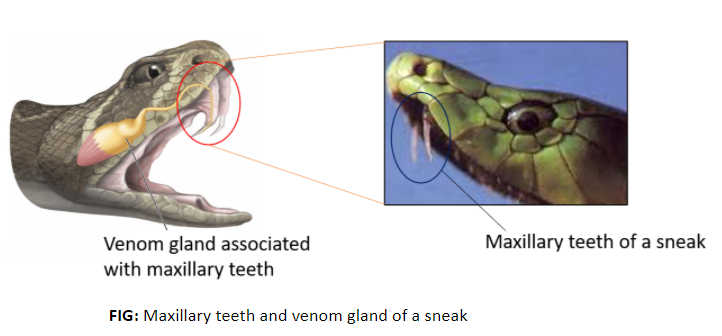
Assertion: The fangs of snake are the Maxillary teeth.
Reason: The poison apparatus in the snake consists of poison-gland, ducts, and fangs.
A. Both Assertion and Reason are correct and Reason is the correct Explanation for Assertion.
B. Both Assertion and Reason are correct but Reason is not the correct Explanation for Assertion.
C. Assertion is correct but Reason is incorrect.
D. Assertion is incorrect but the reason is correct.
Answer
573.9k+ views
Hint: When a snake bites it leaves two spots on the body of the pray.
The spots are nothing but holes that are made by the teeth of the snake.
The poison of the snake is injected into the body of pray by that hole only.
Complete answer: The fangs of a snake are sharp, enlarged maxillary teeth but the maxillary teeth is have some modification in it. So, the assertion is wrong.
The poison apparatus of snakes consist of three parts – a pair of poison-gland, connecting ducts, and a pair of fangs. So, the Reason is correct.
When a snake bites a prey, venom is released immediately and starts working on the nervous system of that pray and within few minutes the pray lost its life or paralyzed.

Thus, the correct answer is option D. Assertion is incorrect but the reason is correct.
Note: The shapes of fangs are sharp, long, hollow, or grooved. The modified maxillary teeth are connected to a small sac in the head of the snake. It is present behind its eyes. Venoms are produced from these sacs. Venoms are poisonous liquid. Nowadays, venom is widely used in research work to identify its medical importance to treat neurodegenerative diseases like Alzheimer’s disease.
The spots are nothing but holes that are made by the teeth of the snake.
The poison of the snake is injected into the body of pray by that hole only.
Complete answer: The fangs of a snake are sharp, enlarged maxillary teeth but the maxillary teeth is have some modification in it. So, the assertion is wrong.
The poison apparatus of snakes consist of three parts – a pair of poison-gland, connecting ducts, and a pair of fangs. So, the Reason is correct.
When a snake bites a prey, venom is released immediately and starts working on the nervous system of that pray and within few minutes the pray lost its life or paralyzed.

Thus, the correct answer is option D. Assertion is incorrect but the reason is correct.
Note: The shapes of fangs are sharp, long, hollow, or grooved. The modified maxillary teeth are connected to a small sac in the head of the snake. It is present behind its eyes. Venoms are produced from these sacs. Venoms are poisonous liquid. Nowadays, venom is widely used in research work to identify its medical importance to treat neurodegenerative diseases like Alzheimer’s disease.
Recently Updated Pages
Master Class 11 Economics: Engaging Questions & Answers for Success

Master Class 11 English: Engaging Questions & Answers for Success

Master Class 11 Social Science: Engaging Questions & Answers for Success

Master Class 11 Biology: Engaging Questions & Answers for Success

Class 11 Question and Answer - Your Ultimate Solutions Guide

Master Class 11 Business Studies: Engaging Questions & Answers for Success

Trending doubts
What is meant by exothermic and endothermic reactions class 11 chemistry CBSE

1 Quintal is equal to a 110 kg b 10 kg c 100kg d 1000 class 11 physics CBSE

What is periodicity class 11 chemistry CBSE

Explain zero factorial class 11 maths CBSE

What is a periderm How does periderm formation take class 11 biology CBSE

What are porins class 11 biology CBSE




